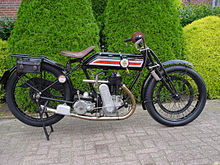
The Rover Company Limited was a British car manufacturing company originally founded in 1878, beginning car manufacturing in 1904. It primarily operated from its base in Solihull, Warwickshire. Rover also manufactured the Land Rover series from 1948 onwards, and created the Range Rover in 1970, which went on to become its most successful and profitable product. Land Rover eventually became a separate company and brand in its own right.

Riley was a British motorcar and bicycle manufacturer from 1890. Riley became part of the Nuffield Organization in 1938 and was merged into the British Leyland Motor Corporation in 1968. In July 1969 British Leyland announced the immediate end of Riley production, although 1969 was a difficult year for the UK automotive industry and many cars from Riley's inventory may have been first registered in 1970.
Triumph Engineering Co Ltd was a British motorcycle manufacturing company, based originally in Coventry and then in Meriden. A new company, Triumph Motorcycles Ltd, based in Hinckley, gained the name rights after the end of the company in the 1980s and is now one of the world's major motorcycle manufacturers.

Velocette is a range of motorcycles made by Veloce Ltd, in Hall Green, Birmingham, England. One of several motorcycle manufacturers in Birmingham, Velocette was a small, family-owned firm, selling almost as many hand-built motorcycles during its lifetime as the mass-produced machines of the giant BSA and Norton concerns. Renowned for the quality of its products, the company was "always in the picture" in international motorcycle racing from the mid-1920s until the 1950s, culminating in two World Championship titles and its legendary and still-unbeaten 24 hours at over 100 mph (161 km/h) record. Veloce, while small, was a great technical innovator and many of its patented designs are commonplace on motorcycles today, including the positive-stop foot shift and swinging arm rear suspension with hydraulic dampers. The business suffered a gradual commercial decline during the late 1960s, eventually closing in February 1971.
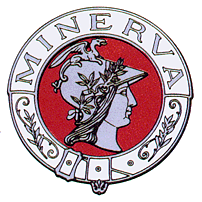
Minerva was a Belgian firm active from 1902 to 1938 and a manufacturer of luxury automobiles. The company became defunct in 1956.

Singer Motors Limited was a British motor vehicle manufacturing business, originally a bicycle manufacturer founded as Singer & Co by George Singer, in 1874 in Coventry, England. Singer & Co's bicycle manufacture continued. From 1901 George Singer's Singer Motor Co made cars and commercial vehicles.
The Scott Motorcycle Company was owned by Scott Motors (Saltaire) Limited, Saltaire, West Yorkshire, England and was a well-known producer of motorcycles and light engines for industry. Founded by Alfred Angas Scott in 1908 as the Scott Engineering Company in Bradford, Yorkshire, Scott motorcycles were produced until 1978.
Initially started in a rented workshop, Alfred moved the business to Hirstwood Works, Hirstwood Road, Saltaire. This building is still standing and has industrial use.

The Swift Motor Company made Swift Cars in Coventry, England from 1900 until 1931. It grew progressively from James Starley's Coventry Sewing Machine Company, via bicycle and motorised cycle manufacture. The cars ranged from a single-cylinder car in 1900 using an MMC engine, through a Swift-engined twin-cylinder 7-horsepower light car in 1904, and a 3-litre model in 1913. After the First World War a successful range was sold during the 1920s, but the Cadet of 1930 was its last vehicle as it could not compete economically with volume manufacturers such as Ford and Morris Motors.

Matchless is one of the oldest marques of British motorcycles, manufactured in Plumstead, London, between 1899 and 1966. A wide range of models were produced under the Matchless name, ranging from small two-strokes to 750 cc four-stroke twins. Matchless had a long history of racing success; a Matchless ridden by Charlie Collier won the first single-cylinder race in the first Isle of Man TT in 1907.

Ariel Motorcycles was a British maker of bicycles and then motorcycles in Bournbrook, Birmingham. It was an innovator in British motorcycling, part of the Ariel marque. The company was sold to BSA in 1951 but the brand survived until 1967. Influential Ariel designers included Val Page and Edward Turner. The last motorcycle-type vehicle to carry the Ariel name was a short-lived three-wheel tilting moped in 1970.
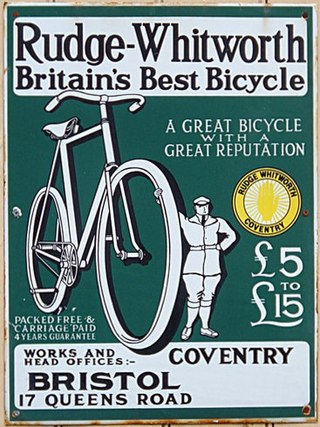
Rudge Whitworth Cycles was a British bicycle, bicycle saddle, motorcycle and sports car wheel manufacturer that resulted from the merger of two bicycle manufacturers in 1894, Whitworth Cycle Co. of Birmingham, founded by Charles Henry Pugh and his two sons Charles Vernon and John, and Rudge Cycle Co. of Coventry.

Douglas was a British motorcycle manufacturer from 1907 to 1957 based in Kingswood, Bristol, owned by the Douglas family, and especially known for its horizontally opposed twin cylinder engined bikes and as manufacturers of speedway machines. The company also built a range of cars between 1913 and 1922.
Rex, Rex Motorcycles, Rex-Acme, was a car and motorcycle company which began in Birmingham, England in 1900. Rex soon merged with a Coventry maker of bicycles and cars named Allard and then later in 1922 the company merged with Coventry's 'Acme' motorcycle company forming 'Rex Acme'. The company existed until 1933, and, in its heyday, was considered one of the greatest names in the British motorcycle industry.
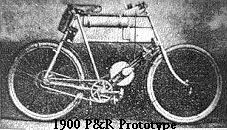
The Phelon & Rayner 1.75 hp was a British motorcycle made by Phelon and Rayner (P&R). There was only one P&R model which had a 1.75 h.p., 260 cc. engine with 66 x 76 mm bore and stroke fitted in a standard bicycle type 28" frame. It was fitted with a surface carburettor, single speed friction disc transmission, a 9 pint combined oil and fuel tank, bicycle pattern front forks and 28 in × 2 in wheels. The colour scheme was black frame and mudguards with an aluminium enameled fuel tank with coach lining.

The Bat Motor Manufacturing Co. Ltd was a British motorcycle manufacturer that operated between 1902 and 1926. Significant innovations developed by the company included one of the first motorcycle suspension systems, with a leading link front fork and a subframe suspended on springs from the main frame.
The Advance Motor Manufacturing Company was a British motorcycle and engine manufacturer established in 1905. As well as supplying aircraft engines to the pioneering monoplane developers, Advance engines were also used by Captain Robert Scott to power Antarctic snow sleds. After the end of the Second World War the company was sold to Sheepbridge Engineering and became a motor supplies organisation.

Quadrant was one of the earliest British motorcycle manufacturers, established in Birmingham in 1901. Famous for their big singles, Quadrant pioneered many innovations that proved important for motorcycle development but struggled after the First World War and the company was wound up in 1928.
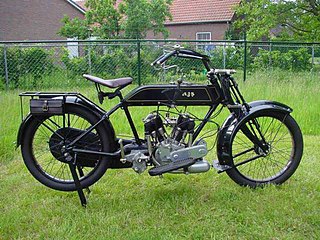
The AJS Model D is a British motorcycle made by A. J. Stevens & Co. Ltd in Wolverhampton between 1912 and 1925. With production halted by the First World War AJS managed to develop the Model D into a popular sidecar machine and it was eventually replaced by the larger capacity AJS Model E.

The Acme Motor Co is a defunct manufacturer of motorcycles that operated from premises in Earlsdon, Coventry. The company started manufacturing in 1902. It was taken over by Rex motorcycles sometime before 1920. In 1922 the name of the company was changed to Coventry Acme Motor Co, later that year the company was merged with Rex motorcycles to form Rex-Acme.

Bridgestone motorcycles were a division of the Bridgestone Tire Co. of Kyōbashi, Tokyo, Japan that produced mopeds and motorcycles from 1952 to 1970. Initially producing power assisted bicycles, the division moved on to producing mopeds and then motorcycles. The motorcycles were technologically advanced and powered by two-stroke engines. The high technical specification resulted in the machines being more expensive compared to other manufacturers models. Production was stopped in 1970 to protect the supply of tyres to other manufacturers.

